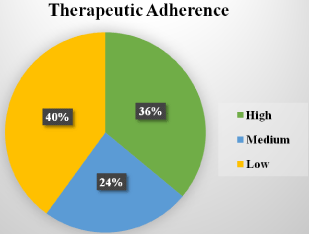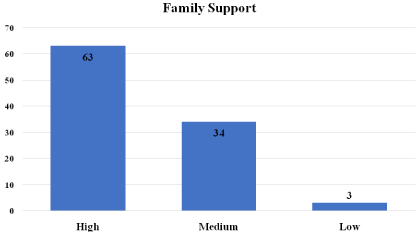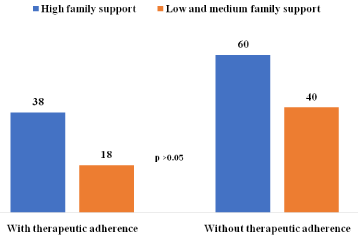Abstract
Background: It is estimated that the lack of therapeutic adherence among patients with Type 2 Diabetes Mellitus (T2D) is 30-51%. Family support reinforces feelings of personal control and plays an important role in overall well-being.
Aim: The purpose of this study is to determine the family typology and pharmacological adherence associated with family support in patients with T2D from the Family Medicine Unit #27 (FMU 27) of Tijuana, Mexico.
Design and Setting: Analytic cross-sectional study.
Methods: Descriptive cross-sectional study in 156 patients with T2D by non-probabilistic quota sampling. The quantitative variables were expressed with mean and standard deviation; frequencies and percentages were used for qualitative variables. In the bivariate analysis, the Chi-Square test and Student's t test were used. As a measure of association, Odds Ratio was estimated with a significant p <0.05.
Results: Therapeutic non-compliance was found in a high percentage of patients (40%), the more frequent age group was between 50-60 years (65%). A high frequency of family support was demonstrated (62%). An association between family support and family composition was identified (p <0.01). The association between therapeutic adherence and family support was not significant (p = 0.4)
Conclusion: We did not find a statistically significant association between family support and therapeutic adherence. The low adherence that exists in patients with T2D in FMU 27 shows us the enormous task as first-contact physicians in the education and maintenance of the patient's health.
Keywords: Type 2 Diabetes Mellitus; Therapeutic adherence; Family Support
Introduction
The family is an open system in constant interaction with the historical, social, economic and cultural environments; it is not a homogeneous unit in its conformation, which indicates that not all are integrated in the same way. The study of family typology implies identifying with which elements it is integrated [1]. The term support is defined as the set of physical and psycho-affective actions necessary to improve a specific situation. Its benefits positively affect a person's feelings of self-esteem, helping them to feel loved and valued, reinforcing feelings of personal control, which plays an important role in general well-being [2].
T2D is defined as a heterogeneous, chronic degenerative systemic disease, with variable degrees of hereditary predisposition and with the participation of various environmental factors [3]. The causes that trigger T2D are unknown most of the time; various risk factors such as overweight and obesity, which are associated with sedentary lifestyle and inadequate diet, influence [4]. According to the American
Diabetes Association, to make the diagnosis of T2D the following are required: glycated hemoglobin ≥ 6.5%, or fasting plasma glucose (no caloric intake for at least eight hours) ≥ 126 mg/dl, or plasma glucose ≥ 200 mg/dl 2 hours after loading 75 grams of glucose, or plasma glucose ≥ 200 mg/dl in patients with classic symptoms of hyperglycemia or hyperglycemic crisis [5]. In patients with T2D we must use non-pharmacological treatment (therapeutic education plan, diet, physical exercises and healthy habits) and pharmacological treatment (when diet and exercise do not achieve glycemic control goals after a period of 3 months), as well as preventive methods in people at high risk to develop it [6].
Data from the International Diabetes Federation report a prevalence of 463 million (9.3%) of adults aged 20-79 years [7]. In Mexico, the National Health and Nutrition Survey of 2016 (ENSANUT MC2016), reported that the prevalence in women was 10.3%, with a higher frequency in the age between 60-69 years (33%), compared to men who correspond to 8% of the population. Of the adults diagnosed with T2D, 88% answered that they do receive drug treatment [8]. The objective of the research was to determine the family typology and pharmacological adherence associated with family support in patients with type 2 Diabetes Mellitus from the Family Medicine Unit #27 of Tijuana, Mexico.
Material and Methods
Study Design and Population
A descriptive cross-sectional study was carried out in Tijuana, Baja California, Mexico, in the period between June and August 2019. The research was developed in the Family Medicine Unit #27 of the Instituto Mexicano del Seguro Social (IMSS). Patients with T2D were included, who attended a monthly medical consultation to control their disease with an age range of 18-60 years and who signed the informed consent. Patients who belonged to Diabet IMSS department; suffering from T1D, gestational diabetes or other types of diabetes were excluded from the study. Patients with incomplete information were eliminated.
Variables
The collection of variables was done with a standardized data form; the variables collected were the following: age, marital status, education and time of evolution of the disease, which were asked directly to the patients; gender, collected through phenotypic characteristics; family typology, was obtained by questioning the family about their development, composition, occupation and family functionality, obtained by applying the 5-item family APGAR, classifying as functional the one with results between 7-10 points. Therapeutic adherence was determined with the Morisky scale of 8 items validated in Spanish, taking as adequate adherence a score greater than or equal to 6 points. To determine family support, an instrument was used to evaluate family support in patients with T2D, it is validate with a Cronbach's alpha of 0.93 and has 24 items, it is carried out to the family member accompanying the patient and explores different areas such as knowledge about disease control, knowledge about complications, attitudes towards the patient and attitudes towards control measures, taking as high family support those with a score greater than or equal to 188 [9-10].
Statistical analysis
The statistical program SPSS version 21 was used. The quantitative variables were expressed as mean and standard deviation, the qualitative variables with frequency and percentage. For the bivariate analysis between the quantitative variables, Student's t test was used; in the categorical variables the Chi-square test was used. As a measure of association, Odds Ratio was estimated between therapeutic adherence and family support in patients with T2D.
Ethics
The study was approved by the Local Health Research Committee with institutional registration number R-2019-204-017. The research was carried out based on the regulations of the General Health Law on Research for Health. The study followed the guidelines that on research and ethical issues are accepted in the standards established in the Declaration of Helsinki. This Research was in accordance with the research and ethics subject guidelines that are established in international standards and instructions. Patient authorization was through informed consent.
Results
156 patients were included with an average age of 53 ± 8.2 years, which associated with therapeutic adherence was not statistically significant (p= 0.05). The population was divided into two groups, one 18-40 years old and the other 41-60 years old, where a higher frequency was observed in those identified within the second group (89%). According to the socioeconomic characteristics, it was identified that 67% were women. In their marital status, 40% of the patients were married and 19% single; 33% indicated that they had studied up to primary level and only 5% had university; of the totality of patients, 40% were classified as employed and 28% were dedicated to the home. The sociodemographic characteristics are described in Table 1.
Variables
n
%
Sex
Men
Women
52
104
33
67
Marital status
Single
Married
27
62
17
40
Free union
30
19
Widow
Divorced
25
12
16
8
Occupation
Employee
Merchant
Housewife
Retired
62
8
44
5
40
5
28
3
Schooling
No education
Primary
Secondary
High school
University
24
52
50
23
7
16
33
32
15
5
Table 1: Sociodemographic characteristics of the population.
36% of the patients had high therapeutic adherence, with predominance in patients without adherence to treatment for T2D (Figure 1). The largest distribution of patients with low therapeutic adherence was in an age range between 50-60 years (65%). The most frequent time of evolution from the diagnosis of T2D was the group of 1-4 years with a frequency of 33%. Due to their family composition, the highest percentage of patients belonged to a simple nuclear family and an extended family with 39% (n= 60) and 34% (n= 53) respectively. According to its development, 70% were classified as traditional; on the other hand, almost all the patients (95%) had a working occupation and 69% perceived a highly functional family. The family characteristics are described in Table 2.
Variables
n
%
Typology (composition)
Simple nuclear
Numerous nuclear
Extensive
Single parent
Family equivalents
60
1
53
31
11
39
1
34
20
7
Typology (developing)
Modern
Traditional
47
109
30
70
Typology (occupation)
Worker
Professional
148
8
95
5
Family functionality
Functional
Mild disfuction
Severe disfunction
108
24
24
70
15
15
Table 2: Familiar characteristics of the population.

Figure 1: Level of therapeutic adherence in patients with T2D.
A high frequency of family support was found in 63% of the patients. For the study, family support was categorized dichotomously; those who presented high family support and medium/low family support (Figure 2). For therapeutic adherence, groups were divided in a similar way, a group with good therapeutic adherence and another group with medium/low adherence. Odds ratio was calculated to evaluate the association between high family support and therapeutic adherence, obtaining a value of 1.24 without finding statistically significant differences (p = 0.416) (Figure 3).

Figure 2: Family support in patients with T2D.

Figure 3: Association between family support and therapeutic adherence.
Discussion and Conclusion
Bello-Escamilla et al (2016), studied 116 older adults with T2D who coincided with our family characteristics: a simple nuclear family composition, having a couple bond and showing family functionality [11]. Regarding the distribution of therapeutic adherence, those who did not adhere prevailed within an age range between 50-60 years, in the same way a greater difficulty was identified for therapeutic compliance between the first and fourth year of diagnosis of the disease, a finding similar to that reported by Ramos-Rangel et al (2017), who reported a higher rate of noncompliance with T2D treatment in 63% of patients, mainly in those between three and five years after diagnosis, with an age range of 51-60 years [10]. Mutashambara-Rwegerera et al (2018) reported a very similar result in patients diagnosed with T2D in a period of less than 5 years (47%); however, they describe a low prevalence of patients not adhered to treatment (18%), which is different from our study [12].
Lack of pharmacological and non- pharmacological adherence has important clinical, economic and social consequences, prevents us from achieving therapeutic control, increases complications and reduces quality of life. Based on the results, it is concluded that a statistically significant association between family support and therapeutic adherence was not observed. Therefore, we must fulfill our duty as specialists in Family Medicine and provide comprehensive care to the individual and their family in the context of the community, breaking the biomedical paradigm, with a biopsychosocial approach, supporting ourselves on the pillars of continuity, comprehensiveness, coordination in the care and orientation about the disease and the family.
References
- Membrillo-Luna A. En Familia: Introduccion al estudio de sus elementos. 1ra. Ed. Mexico, D.F: ETM. 2008.
- Rodriguez-Torres A, Camacho-Ruiz EJ, Escoto-Ponce de Leon MC, Contreras-Landgrave G, Casas-Patino D. Representacion social del apoyo familiar al diabetico en usuarios de una unidad de medicina familiar en Chalco, Estado de México. Medwave. 2014; 14: 1-9.
- Diario Oficial de la Federacion. Mexico: Proyecto de Norma Official Mexicana PROY-NOM-015-SSA2-2018 Para la prevencion, tratamiento y control de la Diabetes Mellitus. 2018.
- Diagnostico y Tratamiento Farmacologico de la Diabetes Mellitus Tipo 2 en el Primer Nivel de Atencion. Guia de Evidencias y Recomendaciones: Guia de Practica Clinica. Mexico, Instituto Mexicano del Seguro Social. 2018.
- American Diabetes Association. Classification and diagnosis of diabetes: Standards of Medical Care in Diabetes-2019. Diabetes Care. 2019; 42: S13-S28.
- Reyes-Saname FA, Perez-Alvarez ML, Figueredo EA, Ramirez-Estupinan M, Jimenez-Rizo Y. Tratamiento actual de la diabetes mellitus tipo 2. Correo Cientifico Medico. 2016; 20: 98-121.
- Internacional Diabetes Federation.
- Instituto Nacional de Salud Publica. Mexico: Encuesta Nacional de Salud y Nutricion de Medio Camino. 2016.
- Penarrieta MI, Flores-Barrios F, Gutierrez-Gomez T, Pinones-Martinez S, Resendiz-Gonzalez E, Quintero-Valle LM. Self-management and family support in chronic diseases. J Nurs Educ. 2015; 5: 73-80.
- Ramos-Rangel Y, Morejon-Suarez R, Gomez-Valdivia M, Reina-Suarez ME, Rangel-Diaz C, Cabrera-Macias Y. Adherencia terapeutica en pacientes con diabetes mellitus tipo 2. Finlay. 2017; 7: 1-9.
- Bello-Escamilla NV, Montoya-Caceres PA. Adherencia al tratamiento farmacológico en adultos diabéticos tipo 2 y sus factores asociados. Gerokomos (Madr.). 2017; 28: 73-77.
- Mutashambara-Rwegerera G, Moshomo T, Gaenamong M, Aderonke- Oyewo T, Gollakota S, Apolinary-Mhimbira F, et al. Antidiabetic medication adherence and associated factors among patients in Botswana; implications for the future. Alexandria Journal of Medicine. 2017; 54: 103-109.
